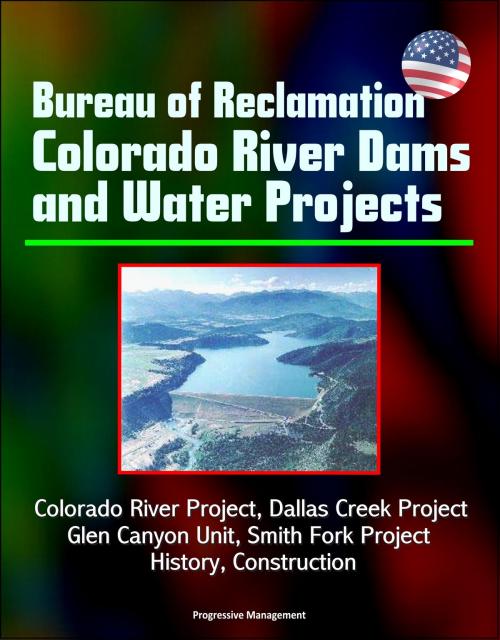Bureau of Reclamation Colorado River Dams and Water Projects: Colorado River Project, Dallas Creek Project, Glen Canyon Unit, Smith Fork Project - History, Construction
Nonfiction, Science & Nature, Technology, Engineering, Civil| Author: | Progressive Management | ISBN: | 9781311011268 |
| Publisher: | Progressive Management | Publication: | October 10, 2014 |
| Imprint: | Smashwords Edition | Language: | English |
| Author: | Progressive Management |
| ISBN: | 9781311011268 |
| Publisher: | Progressive Management |
| Publication: | October 10, 2014 |
| Imprint: | Smashwords Edition |
| Language: | English |
Four documents from the U.S. Bureau of Reclamation provide unique insight into the history of Colorado River dams and water projects.
The Colorado River Project (Marshall Ford Dam) - In 1942, the Bureau of Reclamation, in concert with the Lower Colorado River Authority (LCRA) of Texas, oversaw completion of the Marshall Ford Dam(known by Reclamation as the Colorado River Project) on the Colorado River of Texas (not the "other" Colorado River, which runs through six western states). The dam was built in response to the devastating floods that had plagued the capital city of Austin for decades since its establishment as the state capital in 1846. Through the efforts of Texas' incredibly tenacious politicians, such as Lyndon B. Johnson, the city and the land northwest along the Colorado River basin became the focus of a major flood control and hydro-electric project that included six dams, two of which (the Granite Shoals and Marble Falls dams) were added after World War II.
The Dallas Creek Project - In the high mountain valleys of western Colorado, the land is often rich and fertile. But the short growing season and the lack of readily available water make it difficult for farmers to fully utilize the richness of the region's lands. In addition, the short growing season limits the crops which can be grown to those which tend to have low value per acre, making it difficult for farmers to pay for the elaborate irrigation systems necessary to bring a full supply of water to their lands. While it is possible to develop these rich lands, the costs involved make it almost impossible without some kind of assistance. In the late 1950s, the Bureau of Reclamation developed a solution to the cost problem, and the Dallas Creek Project was one of many projects to benefit from that solution. The Dallas Creek Project is located on the Uncompahgre River in west-central Colorado. The area served by the project comprises most of the Uncompahgre River Basin and includes lands in Montrose, Delta, and Ouray Counties. The project is named for Dallas Creek, a major tributary of the Uncompahgre River. Ridgway Dam and Reservoir, the primary features of the project, are located on the Uncompahgre River a few miles north of the town of Ridgway. Lands served by the project run along both sides of the Uncompahgre River northward from Colona to Delta where the Uncompahgre River feeds into the Gunnison River.
The Glen Canyon Unit, located along the Colorado River in north central Arizona and south central Utah, is one of the more geographically isolated, largest, and most expensive reclamation units ever constructed by the Bureau of Reclamation. It took nearly eight years for crews to top the dam at its height of 710 feet, and another two years for completion of the powerplant. One of four major storage reservoirs along the Colorado and its tributaries as part of the Colorado River Storage Project Act of 1956 (or CRSP), the dam impounds 27,000,000 acre feet—nearly the storage capacity of Hoover Dam—and generates enormous amounts of hydroelectric power for the West.
The Smith Fork Project - When Congressional hearings for the Colorado River Storage Project (CRSP) took place in 1956, Senator Paul Douglas of Illinois, the learned and eloquent former University of Chicago economist, took offense at the notion of paying for reclamation projects on so-called "high-elevation, low-value" farmlands which were doomed to never grow more than cattle forage. The Smith Fork Project in the West Elk foothills of west-central Colorado, sitting at an average elevation of 6300 feet, was such a project. Watering these high desert farms with expensive Federal reclamation projects was a wasteful investment of taxpayers' dollars, claimed Douglas, for even after irrigation participating project lands such as Smith Fork's would not be worth more than a few hundred dollars an acre.
Four documents from the U.S. Bureau of Reclamation provide unique insight into the history of Colorado River dams and water projects.
The Colorado River Project (Marshall Ford Dam) - In 1942, the Bureau of Reclamation, in concert with the Lower Colorado River Authority (LCRA) of Texas, oversaw completion of the Marshall Ford Dam(known by Reclamation as the Colorado River Project) on the Colorado River of Texas (not the "other" Colorado River, which runs through six western states). The dam was built in response to the devastating floods that had plagued the capital city of Austin for decades since its establishment as the state capital in 1846. Through the efforts of Texas' incredibly tenacious politicians, such as Lyndon B. Johnson, the city and the land northwest along the Colorado River basin became the focus of a major flood control and hydro-electric project that included six dams, two of which (the Granite Shoals and Marble Falls dams) were added after World War II.
The Dallas Creek Project - In the high mountain valleys of western Colorado, the land is often rich and fertile. But the short growing season and the lack of readily available water make it difficult for farmers to fully utilize the richness of the region's lands. In addition, the short growing season limits the crops which can be grown to those which tend to have low value per acre, making it difficult for farmers to pay for the elaborate irrigation systems necessary to bring a full supply of water to their lands. While it is possible to develop these rich lands, the costs involved make it almost impossible without some kind of assistance. In the late 1950s, the Bureau of Reclamation developed a solution to the cost problem, and the Dallas Creek Project was one of many projects to benefit from that solution. The Dallas Creek Project is located on the Uncompahgre River in west-central Colorado. The area served by the project comprises most of the Uncompahgre River Basin and includes lands in Montrose, Delta, and Ouray Counties. The project is named for Dallas Creek, a major tributary of the Uncompahgre River. Ridgway Dam and Reservoir, the primary features of the project, are located on the Uncompahgre River a few miles north of the town of Ridgway. Lands served by the project run along both sides of the Uncompahgre River northward from Colona to Delta where the Uncompahgre River feeds into the Gunnison River.
The Glen Canyon Unit, located along the Colorado River in north central Arizona and south central Utah, is one of the more geographically isolated, largest, and most expensive reclamation units ever constructed by the Bureau of Reclamation. It took nearly eight years for crews to top the dam at its height of 710 feet, and another two years for completion of the powerplant. One of four major storage reservoirs along the Colorado and its tributaries as part of the Colorado River Storage Project Act of 1956 (or CRSP), the dam impounds 27,000,000 acre feet—nearly the storage capacity of Hoover Dam—and generates enormous amounts of hydroelectric power for the West.
The Smith Fork Project - When Congressional hearings for the Colorado River Storage Project (CRSP) took place in 1956, Senator Paul Douglas of Illinois, the learned and eloquent former University of Chicago economist, took offense at the notion of paying for reclamation projects on so-called "high-elevation, low-value" farmlands which were doomed to never grow more than cattle forage. The Smith Fork Project in the West Elk foothills of west-central Colorado, sitting at an average elevation of 6300 feet, was such a project. Watering these high desert farms with expensive Federal reclamation projects was a wasteful investment of taxpayers' dollars, claimed Douglas, for even after irrigation participating project lands such as Smith Fork's would not be worth more than a few hundred dollars an acre.















